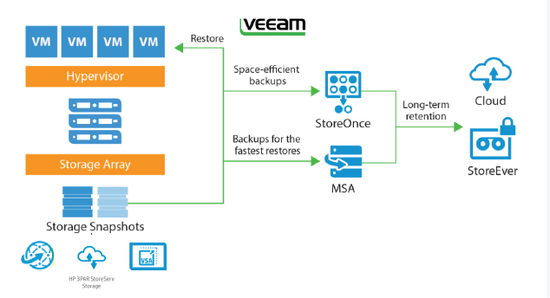Tiered Data Protection: Together We Stand, Veeam & HP
In Italy, the most popular sport is soccer. Everyone follows the championships. Even if you’re not that interested, it’s impossible to avoid the activity that surrounds them—and this includes the Monday coach. This is when you go to any office water cooler or other gathering spot on a Monday during soccer season and everybody there seems to think that they can do a better job than any of the real coaches. (If you are a U.S. football fan, you might recognize this common phenomenon as the Monday morning quarterbacking!)
July 9, 2015

In Italy, the most popular sport is soccer. Everyone follows the championships. Even if you’re not that interested, it’s impossible to avoid the activity that surrounds them—and this includes the Monday coach. This is when you go to any office water cooler or other gathering spot on a Monday during soccer season and everybody there seems to think that they can do a better job than any of the real coaches. (If you are a U.S. football fan, you might recognize this common phenomenon as the Monday morning quarterbacking!)
Data availability reminds me of these endless discussions. Everyone thinks they have the perfect plan to solve any availability problem, and they refuse to even look at other ideas. When it comes to protecting data, however, the problem is that everyone is correct AND wrong at the same time!
Everyone is correct because most of the mainstream and niche solutions adopted by customers are actually good enough to effectively increase availability and improve results. But no solution is perfect or without some gap. If used as a standalone, no solution can completely fulfill the availability needs of modern data centers.
When it comes to storage snapshots, data protection specialists have spent vast amounts of time saying “snapshots are not backups.” Snapshots are copies, which are stored in the same array. If you lose them, you lose both production data and the additional copies.
It’s true that snapshots are not backups, but does this mean they are useless?
No. Snapshots have some great advantages. They can be created quickly and with minimum impact on production storage. Modern storage arrays, like HP 3PAR StoreServ, are designed to allow frequent snapshots, without compromising their performance.
The problem of storing snapshots together with their parent volume may not be resolved as long as everyone thinks of storage snapshots as a single solution to a bigger problem.
Are you ready to think differently about storage snapshots?
No single solution is perfect, so how about teaming/combining different technologies as a solution, so each can fill gaps for the others?
If you add proper backups in addition to storage snapshots, you can overcome the biggest limit of storage snapshots because you immediately have an additional copy that resides outside of the primary storage system. Proper backups can be executed daily to reduce the amount of additional load on the production storage. You can also reduce the Recovery Point Objective, or RPO, by enabling more frequent snapshots.
What about the target storage for those backups?
I know another phrase coming from the same data protection specialists who like to say tape is dead. As long as the price-per-GB for tape backup remains the lowest possible price, tape will be the preferred choice for long-term archival. In addition, the portability of tape can’t be beat. On the other hand, tape is not the preferred choice when you need fast restores with the best possible Recovery Time Objective, or RTO, or when involving random I/O activity. It may also not be ideal when you need more advanced technologies, like Instant VM Recovery, where you can power on a VM directly from the backup medium. For this, you need disk-based storage.
So, again, a single solution’s limits can be eliminated by tiering multiple technologies together. You can use a non-deduplicated storage array for the most critical workloads that you need to restore as fast as possible, a deduplication appliance for all the other data and a tape solution to guarantee longer retention at a reasonable price.
What are the last two components missing in this scenario?
First, you need an offsite copy of your data to protect you from anything that might happen at the primary location. Here, you can think about using solutions such as cloud-based storage services.
Most of all, you need a software solution that’s able to connect all of the individual components together and manage or orchestrate all data movements flawlessly from one tier to the other at the fastest possible speed.
Veeam Backup & Replication v8 is designed with these principles in mind.
Veeam Backup & Replication integration with HP solutions is complete because it supports and reads data directly from 3PAR StoreServ and HP StoreVirtual storage snapshots.

Veeam can store data in both a regular storage array, like HP MSA storage, or in a deduplicated and space-efficient HP StoreOnce Backup array. It can then offload these copies to secondary platforms like HP StoreEver tapes or cloud solutions with Veeam Cloud Connect technology.
Together, Veeam and HP offer a tightly integrated solution for data protection and monitoring that delivers maximum application uptime and enables availability for the modern data center.
 Luca Dell’Oca is EMEA Evangelist with Veeam. Guest blogs such as this one are published monthly, and are part of The VAR Guy’s annual platinum sponsorship.
Luca Dell’Oca is EMEA Evangelist with Veeam. Guest blogs such as this one are published monthly, and are part of The VAR Guy’s annual platinum sponsorship.
About the Author(s)
You May Also Like


